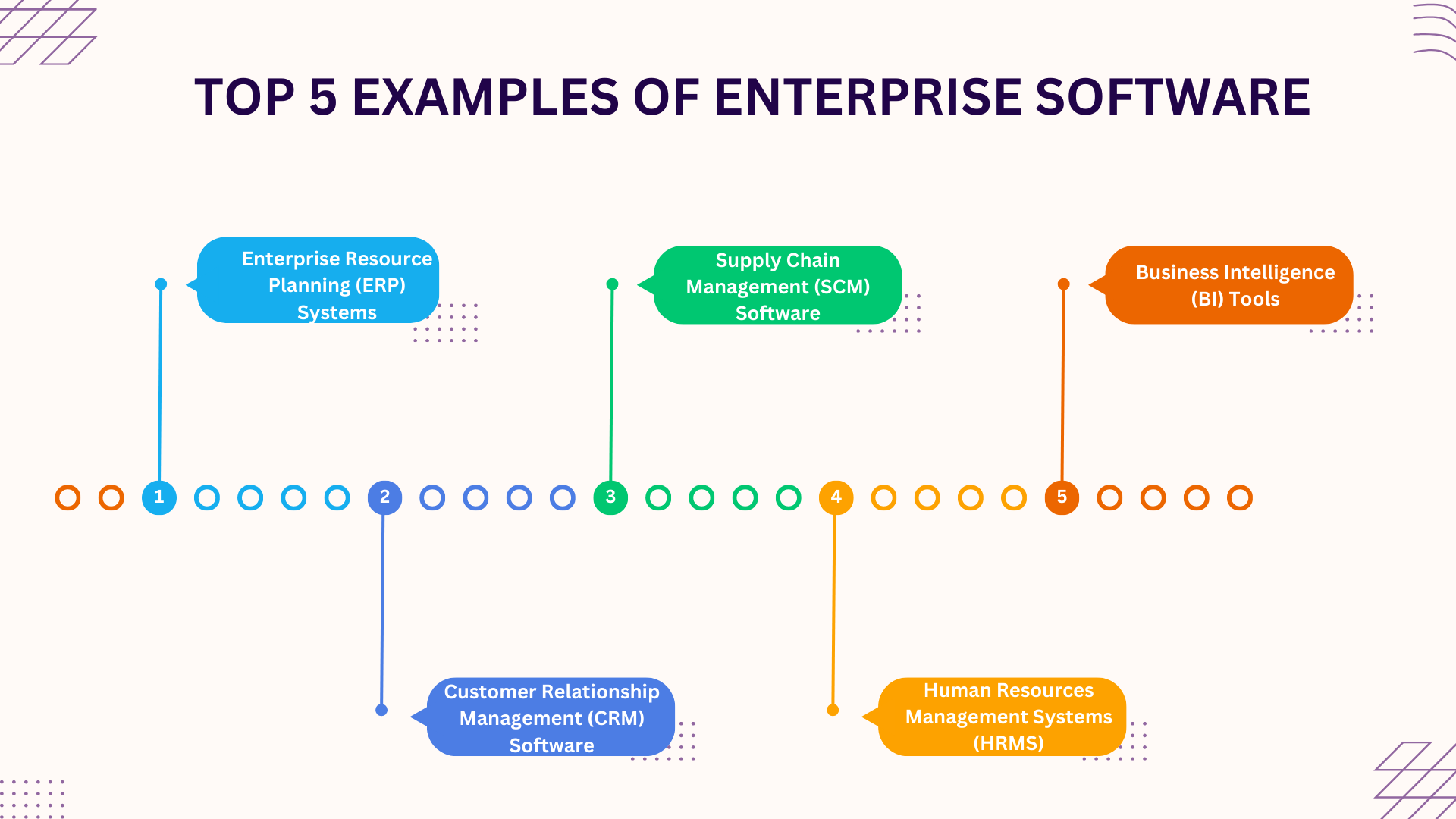Looking to maintain a competitive edge in today’s dynamic and technology-centric landscape? Ensure you harness the potential of Enterprise Software, an innovative solution to transform your business operations.
Embracing enterprise software development provides businesses with a strategic advantage by optimizing processes and enhancing efficiency across various sectors. Recognizing the key benefits of tailored enterprise software development is essential for maximizing success and facilitating informed decision-making.
In this article, we’ll delve into the seven advantages of investing in enterprise software development. Let’s begin by covering the fundamentals.
What is Enterprise Software Development?
In essence, enterprise software development enables businesses and organizations to simplify their operations. With larger companies often facing complex administrative tasks, they require a solution capable of efficiently managing tasks beyond human capabilities.
Top 7 Benefits of Enterprise Software Development
In the following section, we’ve listed the top 7 benefits of custom enterprise software development. Let’s discuss:
1. Tailored Solutions for Individual Business Requirements:
Tailoring software to fit your unique specifications offers a competitive edge in the fiercely competitive corporate landscape. It empowers you to retain control over processes, effectively tackle business challenges, and remain adaptable as your organization evolves.
This customized software can be continuously updated and adjusted according to your business’s evolving needs. Thus, it consistently aligns with your requirements and evolves over time to meet new demands and trends.
For instance, personalized financial software proves invaluable in the banking sector, where security and regulatory compliance are paramount. It ensures that your specific requirements and standards are met, a feat that a standardized approach would struggle to achieve.
2. Cost-Efficiency and Long-Term Savings:
Investing in custom software development represents a savvy financial decision. It entails crafting tools that not only align perfectly with your business needs but also promise cost savings in the long run.
Unlike off-the-shelf solutions, custom software is tailored precisely to your business requirements. It functions akin to a tool that seamlessly integrates with your operations while remaining adaptable to your evolving business landscape. This strategic approach ensures optimal efficiency and cost-effectiveness over the long term.
3. Enhanced Collaboration and Communication:
Enterprise software development tools enhance collaboration and communication within businesses by consolidating data.
These tools enable real-time collaboration by providing task and project management features, ensuring mobile accessibility, and integrating with communication systems.
By simplifying information sharing and teamwork across locations, these tools boost productivity and collaboration, making task and project management more efficient and seamless.
4. Scalability and Adaptability
Scalability and adaptability are paramount for organizations striving to expand and promptly adjust to shifting business dynamics.
Enterprise software provides scalability to handle increased user loads, traffic, and data growth seamlessly, without compromising performance or user experience. This is achieved through data-driven optimization, a flexible design, horizontal scaling, modular architecture, and leveraging cloud services. Such capabilities ensure that customer expectations are met efficiently, fostering business growth.
Moreover, enterprise software offers adaptability to accommodate changes prompted by external factors such as technological advancements, evolving markets, or the introduction of new features. Thanks to its flexible software design, adjustments can be implemented with minimal disruption to the operating system. This adaptability empowers organizations to stay agile and responsive in a constantly changing business landscape.
5. Increased Security and Compliance:
The foremost priority in enterprise software development is undoubtedly security.
Adhering to industry regulations and protecting confidential information are paramount for enhancing security and compliance.
Customized software development enables organizations to meet the specific requirements of their business model. Failure to uphold security and regulatory standards could result in financial losses, legal complications, and reputational damage for the company.
For large firms utilizing specialized accounting software to manage clientele, ensuring security is critical due to the sensitive nature of the data involved. These systems must strictly adhere to security guidelines and best practices to mitigate potential risks.
6. Improved Decision-Making with Data-Driven Insights:
Enterprise software presents businesses with a sophisticated approach to managing and analyzing data, thereby enhancing decision-making through data-driven insights.
By integrating analytics capabilities, organizations can gather, evaluate, and visualize data in real-time. Decision-makers can leverage these insights to identify trends, make informed decisions, and swiftly respond to market fluctuations.
This capability comprises several components:
- Real-Time Data Analysis:
Enterprise software integrates real-time data analytics capabilities, enabling businesses to make informed decisions promptly.
Example: In the retail industry, real-time data analysis allows for the immediate tracking of sales patterns. Decision-makers can adjust marketing campaigns, pricing strategies, and inventory levels in response to evolving market conditions.
- Predictive Analytics:
Enterprise software often incorporates predictive analytics, enabling businesses to forecast future trends and outcomes based on historical data. This empowers decision-makers to anticipate market shifts, proactively respond, and capitalize on emerging opportunities.
Example: Predictive analytics aids in identifying potential market trends and guides investment managers in making informed decisions regarding asset allocation and portfolio adjustments.
- Data Visualization Tools:
Enterprise software features sophisticated data visualization tools that transform complex datasets into visually compelling representations. These tools facilitate effective communication of findings across the organization and expedite insight discovery.
Example: In the medical field, advanced computer tools equipped with data visualization capabilities assist professionals in identifying patterns and trends related to specific treatments or interventions. These tools serve as intelligent assistants, enabling physicians to make optimal patient care decisions.
7. Enhanced Efficiency and Productivity:
Businesses are constantly seeking ways to enhance efficiency and increase productivity. Enterprise software plays a crucial role in achieving these goals by automating routine tasks, reducing manual efforts, and minimizing errors. This automation enables employees to focus on strategic initiatives and other core operations, ultimately boosting overall productivity.
For instance, in the finance department, enterprise software automates financial tasks and monitors marketing efforts. Additionally, it facilitates customized workflows tailored to the unique needs of each business, ensuring seamless operations.
Moreover, enterprise software expedites report generation and provides real-time event visibility, enabling swift and informed decision-making. Its adaptable nature allows for easy scalability to accommodate the organization’s growth.
In summary, enterprise software empowers organizations to become more efficient, adaptable, and competitive in today’s dynamic business landscape.
Top 5 Examples of Enterprise Software
In the following section, we’ve listed some crucial examples of enterprise software. Let’s discuss:

- Enterprise Resource Planning (ERP) Systems:
ERP systems consolidate essential business processes into a unified framework, effectively managing inventory, finance, human resources, supply chain, risk compliance, procurement, and customer relationship management. They provide a comprehensive view of the company’s data and operations.
Examples of prominent ERP systems include:
- SAP Business Suite: Renowned for its comprehensive suite of modules covering various aspects of business operations, SAP Business Suite offers robust solutions for enterprise resource planning.
- Microsoft Dynamics 365: Microsoft Dynamics 365 is a versatile ERP platform that seamlessly integrates with other Microsoft products, providing organizations with advanced capabilities for managing their business processes efficiently.
- Customer Relationship Management (CRM) Software:
CRM software holds a dominant position in the market, with a projected market volume expected to reach US$88.19 billion by 2024.
Utilizing CRM software provides organizations with a competitive edge by acting as an intelligent contact list, offering tailored advantages. This includes enhancing client satisfaction, improving customer relations, and optimizing sales processes. Typically, CRM software encompasses features such as contact management, sales tracking, and customer support.
Key examples of CRM software include:
- Salesforce: Renowned for its comprehensive suite of CRM tools and cloud-based solutions, Salesforce offers businesses a robust platform for managing customer relationships and driving sales growth.
- Zoho CRM: Zoho CRM provides businesses with customizable and user-friendly CRM solutions designed to streamline sales processes, enhance customer engagement, and boost productivity.
- HubSpot CRM: HubSpot CRM offers a user-friendly interface and powerful automation tools to help businesses manage contacts, track deals, and improve customer interactions effectively.
- Supply Chain Management (SCM) Software:
Supply chain management serves as a unifying element for numerous businesses and industries, facilitating the execution of processes and operations. It plays a vital role in integrating various procedures, enhancing customer satisfaction, and mitigating losses.
Supply chain management software plays a pivotal role in streamlining and overseeing purchasing, distribution, and production processes. By enhancing visibility, efficiency, and communication throughout the entire supply chain, it enables organizations to optimize their operations effectively.
Prominent examples of SCM software include:
- SAP: SAP offers comprehensive SCM solutions that enable businesses to optimize their supply chain operations, enhance collaboration, and drive business growth through improved efficiency and responsiveness.
- IBM Supply Chain Insights: IBM provides innovative SCM solutions powered by advanced analytics and artificial intelligence, helping businesses gain valuable insights into their supply chain processes and make informed decisions to improve performance and agility.
- Oracle SCM Cloud: Oracle SCM Cloud offers a suite of SCM applications designed to streamline supply chain operations, improve visibility, and drive innovation. It enables businesses to adapt quickly to changing market demands and enhance customer satisfaction.
- Human Resources Management Systems (HRMS):
HRMS software facilitates the management and streamlining of HR operations and functions. It encompasses various tasks such as recruitment, employee data management, performance monitoring, payroll processing, talent management, attendance tracking, and employee training. Additionally, it centralizes HR data and automates cumbersome processes to enhance efficiency.
Key examples of HRMS software include:
- Zoho People: Zoho People offers comprehensive HR solutions designed to simplify HR processes, enhance employee engagement, and streamline workforce management.
- PeopleForce: PeopleForce provides a user-friendly HR platform that encompasses various HR functions, including recruitment, performance management, payroll processing, and talent management.
- BambooHR: BambooHR offers intuitive HR software that enables businesses to manage employee data, track attendance, streamline onboarding processes, and facilitate performance reviews effectively.
- Business Intelligence (BI) Tools:
Business Intelligence tools empower organizations to collect, analyze, and visualize data to facilitate decision-making. These tools provide insights into consumer behavior, market trends, and overall business performance, aiding strategic decision-making processes.
Examples of prominent BI tools include:
- Salesforce: Salesforce offers powerful BI capabilities that enable businesses to analyze customer data, track sales performance, and gain insights into marketing effectiveness.
- Microsoft Power BI: Microsoft Power BI is a versatile BI platform that enables users to create interactive dashboards, reports, and data visualizations from various sources, allowing for informed decision-making and data-driven insights.
- Tableau: Tableau offers intuitive data visualization and analytics tools that enable businesses to explore and understand their data more effectively. It provides interactive dashboards and robust analytics features to drive actionable insights and informed decision-making.
Thank you for reading. For continued insights and in-depth discussions, please follow our blogs at Ezeiatech.







